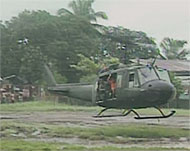No signs of life at Philippine school
Rescuers looking for survivors from the mudslide in the Philippines have been digging closer to a buried elementary school, although officials have said that no signs of life have been detected.

The school has become the focus of a hunt for about 1400 people thought to have been entombed by Friday’s massive landslide.
On Tuesday nearly 1000 rescuers from at least five countries were battling muddy terrain made even more treacherous by heavy overnight rain.
The bad weather has set back efforts to unearth homes and other buildings in what was once the vibrant farming village of Guinsaugon.
Bowie Trent, a US marine, said: “The rain just kept pounding last night. The mud was real difficult to navigate and walk on,
our main obstacle now is the terrain. It changed overnight.”
Four days after an entire mountainside crashed onto the village in Leyte Island, hopes of finding any survivors were almost gone.
Malaysian experts using listening probes said they had heard vibrations, but were unsure if it was an indication of life.
Cheng-Tsung Lu, leader of a specialist Taiwanese team, said: “We have not detected any sign of life so far.”
Weather slows rescue
Cheng said the school, which is feared to contain the bodies of 240 pupils and staff, was just under three metres of soil and rubble and not 20 to 30 metres as was first thought.
The force of the landslide, triggered by two weeks of abnormally heavy rain, had torn the school from its foundations and pushed it to a new location.
 |
|
The search continued despite |
With aid and specialist equipment and trucks pouring in from around the world, the biggest obstacle was the weather.
Despite heavy rain the search continued overnight on Monday after emergency lighting was installed.
But the rain reshaped the sea of mud that now covers the village to an extent of 9sq km.
Malaysian, American and Filipino rescuers used a big log to bridge a creek that had sprung up overnight.
Rescuers temporarily suspended operations around midnight for safety reasons after minor earth slippages.
Death toll
The civil defence office in Manila put the latest confirmed toll at 84.
Nearly 400 people who were out of the village when the disaster struck survived, leaving an estimated 1400 buried. Only about 20 were pulled alive from the slide.
Rudy Duhiling, 28,a coconut harvester, was collecting copra on the mountainside.
“I thought I was dead. I was just 100 metres away when the earth began moving. In seconds, the rolling rubble had hit my home. The coconut trees rushed down the mountainside,” he said.
 |
|
Only about 20 have been pulled |
“I yelled to the other copra harvesters and they ran out. I told them the earth had slid and that we must go. Our homes have been destroyed. They said, ‘Impossible’,” Duhiling recalled.
“We descended and found a desert.”
While his wife and child survived, he lost his mother and 20 other relatives.
Aid has poured in from all over the world.
The US military has committed about 2500 to 3000 troops to the rescue and relief operation to join Philippine military and civilian rescuers and Malaysians and Taiwanese.
A Spanish canine unit was the latest to arrive at the scene.